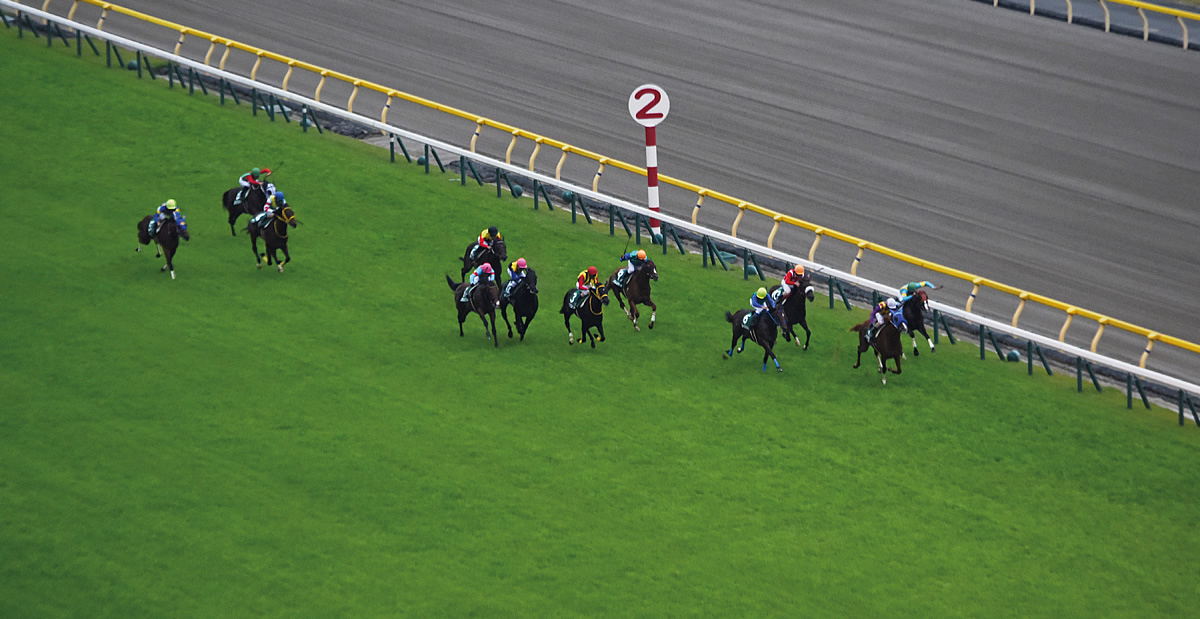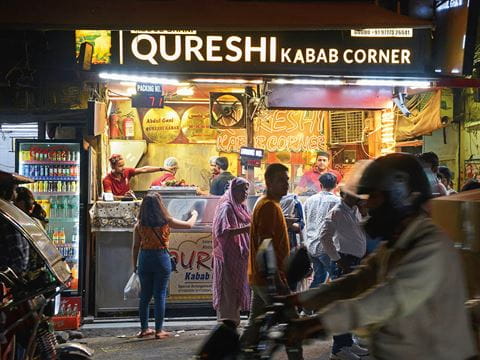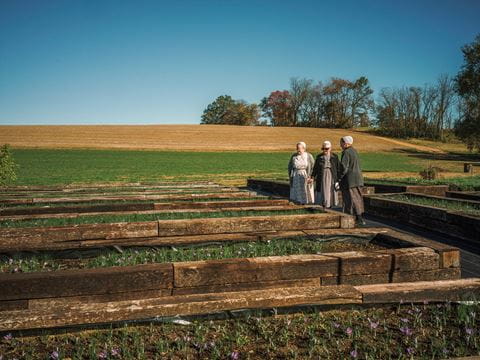
Running for the Royal Cup
An Arabian thoroughbred’s track performance in 1989 in Tokyo spurred the creation of a two-nation symbol of friendly relations: Japan’s annual Saudi Arabia Royal Cup, whose 18th trophy winner recently claimed victory by no more than a nose.
Written by Matthew Teller Photos and video by Steve Shelton

Spectator gates open at precisely nine a.m., and fans have a race of their own to claim favored spots for viewing the day’s lineup of a dozen races capped by the Royal Cup.
It’s early on a weekend morning, and the gates are closed. But someone, somewhere, must have given a signal, because the uniformed officials end their milling and move into place. One tilts his peaked cap to scratch his forehead. Another laces her white-gloved fingers together as she walks, pulling wrinkles out of the fabric, heels clicking on the immaculate stone tiles. And in the corner, a stern supervisor watches, legs spread, creases sharp as knives, clenched right fist by his hip, narrowed eyes flicking to his raised left wrist in a model of alert timekeeping.
On the other side of the gates, those at the front are the keenest. Mr. Daisaku—“Call me Duke,” he says, with a nod, from under a mop of wavy pepper-and-salt hair—got here at six a.m. to be sure of securing his favorite position when the gates open.
Was anyone else here at that time? I ask naively.
Duke points across to his neighbor. Mr. Sakura camped outside the gates all night, Duke says. Sakura looks a stolid type, not embarrassed by my attention exactly, but unwilling to give too much away. I wonder if he and Duke are rivals.
All night? I ask. Why?

Trackside viewing secured, an early bird reads a program while groundskeepers check the turf track of the world’s largest horse racing stadium.
“Just because I felt like it,” Sakura says, unsmiling. “I often do.”
I want to talk more, but something is happening. There’s an echoing announcement in bright but unmistakably steely tones, and all those outside the gates pick up their bags. Officials ready themselves. The man with the creases lifts his eyes from his watch. It’s precisely nine a.m. With a squeak and a rattle, the gates at Tokyo Racecourse begin to rise.
Tokyo Racecourse boggles the mind. It dates from 1933, built about 30 kilometers west of downtown Tokyo in Fuchu, then a historic riverside town on an important commercial highway and today a comfortably upmarket dormitory suburb fed by multiple, crisscrossing train lines.
But the location isn’t the selling point. It’s the size of the place, particularly since a top-to-toe revamp in 2007.
As you enter, it’s not hard to believe this is the largest horse-racing venue in the world, capable of holding as many as 233,000 people. Make your way through the gilded halls, with their tv screens, betting machines, snack stands, restaurant counters and information windows, and out onto the trackside. There, the roof of the six-tiered Fuji View grandstand looms more than 50 meters overhead like a sheltering canopy. Look out across a 80-hectare expanse of green, past one of the biggest video screens in the world, 11 meters high and more than 66 meters long, set up in center field opposite the prime seats. And, yes, sunny skies do indeed lend distant views of Mount Fuji, some 80 kilometers to the southwest.

Horses finish one of the early races on October 10, 2015. The first time a thoroughbred from Saudi Arabia raced in Japan was in 1989. Named Ibn Bey (“Nobleman’s Son”), he and his strong showing inspired the ideas for both the Saudi Arabia Royal Cup and a sister race in Riyadh, the Japan Cup, now in its 14th year.
The main turf course is a circuit of almost 2¼ kilometers—or, in racing parlance, slightly over one mile two and one-third furlongs. Running inside the turf course are a narrower dirt course and a steeplechase course.
But what sets apart the track are its undulations—a gentle downward slope and a sharp rise on the back stretch, followed by another gentle drop round the penultimate (third) corner. Then there’s a punishing climb as horses enter the dramatic home stretch, a seemingly never-ending run of 525 meters to the post. The grade only evens out halfway along.
Received wisdom has it that downward momentum around the third corner favors frontrunners. But in reality that merely sets up a battle round the last corner. A jockey in front entering the home straight might be tempted to drive too hard up the hill, leaving the horse short approaching the post. But keeping something in reserve by taking it easy down the slope risks giving the horse too much to do on that long, long hill toward home.
It’s all about the psychology of the last corner.
Driving from the front demands guts and raw power. Coming from behind needs a tactician, able to play an inch-perfect long game without losing cool. When the starting-gates open, who’s got what it takes?

On the grassy center of the track, fans picnic and enjoy cuisine from “kitchen-cars” parked in the infield. “The boys might be here for the horses, but the girls are here for the food!” says Shoko Otani, third from right. Tokyo author and racing fan Makoto Yoshikawa observes that at horse races in Japan today, “you see so many young people, and there just isn’t the difference between income levels, which is great. People enjoy the culture equally.”
“I’m a big fan of horse racing.”
Hideki Koike beams as he says this and urges me to take another slice of—needless to say—the best sashimi this first-time visitor to Tokyo has ever tasted. A counselor at Aramco Asia Japan, Koike has had a distinguished career in the oil and gas industry. But he has also long nurtured a dream.
“I was part of a [Japanese] delegation that visited Saudi Arabia in 1973 to study conditions for establishing a joint venture. In 1984 they asked me to set up an office in Japan to represent the kingdom in Asia. I’ve been working [like this] for many years. But throughout that time I wanted to bring Saudi Arabia closer to the Japanese public, not just through our oil and gas trade. I thought it would be a good idea to use horse racing and to use the Arabian horse’s bloodline.”
Modern racehorses are thoroughbreds, a term referring chiefly to a breed specifically developed for speed, stamina and athleticism. All thoroughbreds racing in the world today—somewhere around half a million animals—can trace their bloodline back to three stallions imported into England from the Middle East between the 1680s and 1729: the Byerley Turk (of unknown origin), the Darley Arabian (from Aleppo in Syria) and the Godolphin Arabian (foaled in Yemen, exported via Syria and Tunisia). As New Scientist reported in 2005, 95 percent of racehorses active today hold genetic material that can be traced back to the Darley Arabian alone.
That foundational link to Arabia, mixed with the enthusiasm for racing in Japan—the Japan Cup, run every November, is one of the world’s richest horse races, with a purse of ¥624 million (around $5.5 million)—pointed the way forward. So did the appearance in the 1980s of a very special horse.
Ibn Bey (“Nobleman’s Son” in Arabic) was a chestnut thoroughbred, trained in England and owned by Prince Fahd ibn Salman. After some success in European racing, he arrived in Tokyo in 1989 as a five-year-old to compete for the Japan Cup, gaining headlines as the first Saudi-related horse to race in Japan. Sensationally, he led the field for most of the way, but was overtaken in the home straight, eventually finishing sixth.
“Ibn Bey made very impressive running,” says Kiyohiko Kakita, international manager at the Japan Racing Association (jra). “He was an impressive horse. Many Japanese loved him.”

Businessmen and horse owners watch from a private section.
“That was when the name ‘Saudi Arabia Royal Cup’ first came to me,” recalls Koike.
Efforts by Koike, the jra and then-Saudi Ambassador Bashir Kurdi culminated in June 1999 with the first running of the Tokyo High Jump, a minor race to which the title “Saudi Arabia Royal Cup” was appended. Work at the Equestrian Club of Riyadh to compile a Saudi studbook, a register of thoroughbred bloodlines, led to the kingdom’s acceptance in 2002 into the Asian Racing Federation, and the same year saw the first running of the reciprocal Japan Cup at the Equestrian Club’s King Abdulaziz Racecourse in Janadriyah, outside Riyadh.
By 2007 the Saudi-promoted race in Tokyo had been upgraded to “international grade iii,” run over the flat and retitled the Fuji Stakes, drawing wider attention and more prestigious runners.
“But always the name of our race was attached to other titles,” says Koike. “We needed a single, authentic name.”
Last year, before the 18th running, the jra agreed: From 2015 onward the race would be known simply as the Saudi Arabia Royal Cup.
From a total purse in 2015 of ¥61.6 million (about $540,000), the winner would receive ¥32.4 million (about $280,000)—all of it, as with all races in Japan, supplied by the government-owned jra through public funds and ticket receipts. It’s a project of shared goodwill: Saudi financial involvement takes the form of the original Royal Cup, a gift in 1999 from then-Crown Prince (later King) Abdullah ibn Abdulaziz.
The jra also reinvented the race as one specifically for younger horses—two-year-olds—run over 1,600 meters (approximately one mile) and slotted into the racing calendar in October. Koike was delighted.
“Our race is now the one and only race in Japan named directly after a foreign country, with the trophy from the head of state. And the jra has also placed the Saudi Arabia Royal Cup as the prestigious first stepping-stone for these horses on their challenge towards the Japanese Derby, which is held in May each year. Internationally it will be even more recognized and, of course, Japanese horse racing fans will pay much more attention.”
The last I see of Duke, he has squeezed under the gates as they rattle upward and is sprinting up the steps into the grandstand complex to claim his spot. Mr. Sakura, I guess, is already ahead of him. All along the length of the gates, crowds of men and women are following suit, rushing to claim favored locations trackside long before the action begins. And this is just one of multiple entrances all around the racecourse that are opening simultaneously.
The day’s card looks packed to me: 12 races, with the feature event, the Saudi Arabia Royal Cup, due for the off at 3:45 p.m. I head over to the stabling area, beyond the bustle of the track, where things are still quiet. A gentle wind rustles oaks that shade long, low barns where racehorses wait before their big moment.
Wild Dollar, a runner in the eighth race today, is being washed, grimacing as the spray rolls down his nose but allowing the stable hand to rub water carefully around his eyes.
Another stable hand is leading a more nervous horse round and round on a tight circuit under an avenue of oaks. There is much whinnying and snorting.

Straining at the finish, a jockey whips the shoulder of his thoroughbred mount.
“This is Sugano Lambada,” says the stable hand, who gives his name as Mr. Ihara. “She’s a two-year-old filly, racing tomorrow. I’m just walking her around; she needs to let off a bit of energy.”
It could be a stable anywhere. But it’s when you go trackside that the Japanese difference becomes apparent. After intensive promotional campaigns by the jra to reposition horse racing in popular culture, this has become a sociable day out for people from all walks of life. Roaming through the grandstand area and down to the grassy lawns beside the rail at the quiet first corner, I see and chat with middle-aged businesspeople, young professionals, students, even family groups with small children.
Yuto Sumi, 25, a student from Osaka who makes golf equipment, is here with a group of friends, picnicking together on a blue tarpaulin laid out on the grass. He’s examining the racing program closely as I ask about the Royal Cup.
“It’s a big race,” he says, distractedly. “Not huge, but a small big race.”
Sitting cross-legged across from him, Shoko Otani, a film student from Tokyo, rolls her eyes and laughs.
“The boys might be here for the horses, but the girls are here for the food!” she says with a grin, nudging her neighbors.

That all of today’s thoroughbreds worldwide descend from just three Middle Eastern stallions highlights the connection between modern racing and the Middle East—a connection Hideki Koike, a counselor with Aramco Asia Japan, determined to make more tangible in Japan by working with the Equestrian Club of Riyadh and the Japan Racing Association to establish the Saudi Arabia Royal Cup. Koike explains that in addition to its purse and trophy, the Cup is also a “prestigious first stepping-stone” in the competition for the annual Japanese Derby.
Farther along the grass, Takanari Miyata, 29, and Yosuke Ikubo, 32, pals from the Tokyo suburbs, are here together on their day off. They cheerfully pose for selfies while we chat. Beside them professional women with expensive cameras lean together to discuss racing forms and compare betting slips. Older men in baseball caps chew the fat.
In center field, beside the children’s playground, “kitchen-cars”—the Japanese version of food trucks—manufacture equal quantities of savory aroma and happy banter, creating an atmosphere all their own. Strollers are left parked haphazardly between temporarily discarded sneakers and picnic-ware branded with the stylized wide-eyed figures of Japanese manga animation.
I drift over to the paddock, the enclosed ring where the horses for each race are paraded for observers to gauge their fitness, mood and readiness. It’s a world apart from the cheerful hubbub trackside. Rumpled men in plaid shirts are still discussing finer points of form, but here many of the watchers are quiet, serious insiders: owners, trainers and high-rollers in sharp suits and designer outfits. As the horses for the next race troop past—magnificent, tall, athletic animals, alert and powerful—there’s an unmistakable air of reverential respect, and I’m sure it’s not just about the money changing hands.
Down by the rail, watching one of the early race victors enter the winner’s enclosure, stands Hirotaka Yamagishi, 24, a communications-technology student at a local university. He tells me he’s a big fan of Vodka, one of the most successful Japanese thoroughbreds, winner of the Japan Cup and the first filly to win the Japanese Derby in more than six decades.
“I watch every week,” he says. “I’ve won some money, but it’s the racing. I love it. It’s so exciting.”
Back on an upper level of the grandstand, I sit down with distinguished Japanese author and horse-racing enthusiast Makoto Yoshikawa. He is dressed formally—dark suit, white shirt and sober tie, gray hair straggling over his collar—and he chooses his words carefully.

By a nose, Brave Smash crosses the photo-finish line to win the 1,600-meter Saudi Arabia Royal Cup and earn the two-year-old and owner ¥32.4 million ($280,000).
“It really struck me that in Europe, for major races at the big tracks, you don’t see many of the younger generation, and the crowd tends to be split between upper classes and ordinary people. Here, you see so many young people, and there just isn’t the difference between income levels, which is great. People enjoy the culture equally.”
I ask him what that culture really means here.
“Look at Japanese retail stores,” he says. “They’re disappearing. Things are getting larger and larger. Big business. It’s all so impersonal. But if someone comes to the race track, it’s still a human experience. Everybody is friendly, chatting together. The impression is that horse racing is all about gambling—but it’s not. People gather here to enjoy the community.”
I ask how he came to love racing. Yoshikawa lifts his head and looks out as horses gather for the start of one of the support races, amid bubbling excitement from the trackside announcer and the crowds watching.
“It was very mysterious for me,” he says. “You can’t touch the will of the horse. I used to go to a farm where thoroughbreds were being trained and raced, and I loved it. Nobody at that time was writing about horse culture. I found myself getting more and more deeply involved.”
The afternoon is moving on, crowds are thickening, and anticipation is building. I hook up again with Hideki Koike, who is busy working the vip room.
“We invite quite a few guests from the political, business and art communities, to help get them more interested in what’s going on between Japan and Saudi Arabia,” he explains. “It’s a useful role of this race, to build links like this.”
Business leader Hiromasa Yonekura concurs, sketching the developing background between Japan and Saudi Arabia that is extending beyond trade links. It’s a theme I pursue with Nobuhisa Degawa, a senior analyst with the Japan Broadcasting Corporation nhk.
“Over the last couple of decades, Japan has been widening its cooperation with Saudi Arabia, into academic exchanges, technology and so on,” Degawa tells me.

In the winner's circle, victorious jockey Norihiro Yokoyama, far right, looks on as Adel ibn Abdullah Al Mazroa, general manager of the Equestrian Club of Riyadh, far left, presents owner Takaya Shimakawa the 2015 Saudi Arabia Royal Cup trophy.
“Japanese film—and especially manga—is becoming popular among Saudi youth, and Saudi culture is becoming more familiar to Japanese people through student exchanges and tourism. Horse racing is a part of that. It’s important for bilateral relations, an example of civil diplomacy. People here have no real idea how popular horse racing is in the Middle East.”
As we talk, a trumpet over the public-address system announces the big race of the day—the Saudi Arabia Royal Cup. We watch as the 12 runners—all Japanese owned and trained—are led into the starting gates at the far side of the track.
Then it’s all over in less than two minutes, and it feels like a textbook Tokyo Racecourse upset.
Crown Sky leads along the back straight and holds that lead round those difficult corners keeping tight to the rail. Entering the home straight, he is flying and looks to be in a perfect position to storm up the slope for home. But he’s gone too soon. It’s the psychology of that final corner.
As Crown Sky reaches the top of that hill on the home straight, with 300 meters to go, he runs out of juice. In seconds he is out of the picture as an unfancied outsider, Brave Smash, comes powering through from sixth to fourth to first, successfully holding off desperate bids from two late challengers to win by a “nose”—racing parlance for a few centimeters.
The roar that echoes back off the six tiers of that grandstand as the runners flash past the post is a sound to remember.
Heaving and sweating, but, from the looks of him, ready to do it all again, Brave Smash takes the attention of the winner’s enclosure in his stride. The general manager of the Equestrian Club of Riyadh, Adel ibn Abdullah Al Mazroa, resplendent in gold-trimmed robes, presents the Royal Cup trophy to the winning owner, Takaya Shimakawa, also congratulating trainer Michihiro Ogasa and veteran jockey Norihiro Yokoyama.

After presenting the Royal Cup, Al Mazroa waves to horse-racing fans and media. Japanese news columnist Yuzo Waki calls the race "one of the most impressive examples of the fact that we share common ground."
“All the time I say to Japanese people, please, don’t think Japanese and Saudis live in different worlds,” Yuzo Waki says to me, up in the grandstand. Waki is a columnist for the Japanese news organization Nikkei and has been reporting on the Middle East for 40 years.
“We have common ground. And this race is one of the most impressive examples of the fact we share common ground.”
The days of token high-level cultural exchanges are giving way to something much more vibrant, he says.
“The Japanese government used to promote traditional culture: our embassies in the Middle East would focus on ikebana [formal flower arranging] or kabuki [classical drama]. But now people are growing fond of contemporary Japanese culture—film, animation. Lots of cultural figures have visited the region: The designer Hanae Mori is one example. Contemporary Arab culture is not so familiar to Japanese, but when the Iraqi-born architect Zaha Hadid competed to design the new national stadium in Tokyo, for instance, many Japanese discovered that there were contemporary architects in the Middle East. This race is a new example of that interaction.”
So what, I ask Hideki Koike, does the future hold?
“The ultimate goal is to bring the Saudi Arabia Royal Cup to Grade ii level,” he says.
“If we can keep attracting competitive horses, the international system will recognize this. The Saudi royal family and the Japanese imperial household have both traditionally shown strong interest in horse racing—what’s been called the ‘king of sports and the sport of kings.’ It’s a common legacy, shared by humankind over some 5,000 years of coexistence with horses. I hope this sharing, and celebration of horse culture, will continue.”
About the Author

Matthew Teller
Matthew Teller is a UK-based writer and journalist. His latest book, Nine Quarters of Jerusalem: A New Biography of the Old City, was published last year. Follow him on X (formerly Twitter) @matthewteller and at matthewteller.com.
Steve Shelton
Seattle-based multimedia journalist Steve Shelton has covered stories in the US, Middle East, Balkans, Central America and Sudan for a wide variety of news publications as well as nonprofits and commercial clients.
You may also be interested in...

Couscous for Lunch or Dinner: Algerian Pasta Soup With Labneh
Food
The berkoukes are giant couscous balls cooked into soups and stews, with little differentiation across North Africa and the Levant.
From Sultan’s Kitchen to Delhi’s Streets: Ni‘matnāma Lives On
Food
A sultan’s 500-year-old cookbook still ripples across South Asia, from kitchens to street stalls to celebratory tables, preserving centuries of technique and taste.
The American Hands Weaving Legacies From Saffron Threads
Science & Nature
Meet the keepers of US-grown saffron—a spice prized around the world—who have cultivated it as a culturally important ingredient for generations.